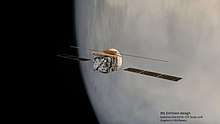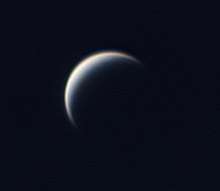EnVision (spacecraft)
EnVision is a proposed orbital mission to Venus that would perform high-resolution radar mapping and atmospheric studies.[3][1] The mission would help scientists understand the relationships between its geological activity and the atmosphere, and it would investigate why Venus and Earth took such different evolutionary paths. The mission is studied in collaboration with NASA, with the potential sharing of responsibilities currently under assessment.

| Mission type | Reconnaissance |
|---|---|
| Operator | ESA |
| Website | envisionvenus |
| Mission duration | 4.5 years (nominal) |
| Spacecraft properties | |
| Manufacturer | In Competition |
| Launch mass | 2607 kg |
| BOL mass | 2537 kg (notional)[1] |
| Dry mass | 1277 kg |
| Payload mass | 255 kg |
| Power | Max. 2.35 kW |
| Start of mission | |
| Launch date | 2032 (proposed) |
| Rocket | Ariane 6.2[2][1] |
| Launch site | Guiana Space Centre (CSG) |
| Contractor | Arianespace |
| Venus orbiter | |
| Orbital parameters | |
| Peri altitude | 220 km |
| Apo altitude | 470 km |
| Transponders | |
| Band | X band, Ka band[1] |
Overview
The concept was selected in May 2018 as a finalist to become the fifth Medium-class mission (M5) of the Cosmic Vision programme by the European Space Agency (ESA). The mission is studied in collaboration with the United States' National Aeronautics and Space Administration (NASA), with the potential sharing of responsibilities currently under science, technical and programmatic assessment. The other two finalists are SPICA, an infrared space telescope, and THESEUS, a gamma-ray space observatory. The winner will be selected in 2021 and it would launch in 2032.[4][5]
If selected, EnVision would be launched on an Ariane 6.2 launch vehicle, giving a cruising time of about five months; after six months of aerobraking around Venus, it would begin a four-year mission at 259 km (161 mi) above Venus' surface.[4] EnVision would be capable of detecting centimetre-scale surface changes that would enable characterisation of volcanic and tectonic activity, and estimate rates of weathering and surface alteration.[1][2] The mission cost is estimated at €544 million.[1]
The Lead Scientist of EnVision is Richard Ghail, Royal Holloway, University of London.[6] The two deputy lead scientists are Colin Wilson, University of Oxford, UK (Science investigation lead) and Thomas Widemann, LESIA, Paris Observatory, France (Programme management lead).[2][7]
Science goals
Core science measurements are: high-resolution mapping of specific targets, surface change, geomorphology, topography, subsurface, thermal emission, SO
2, H
2O, D/H ratio, gravity, spin rate, and spin axis. The specific mission's goals are:[1]
- Determine the level and nature of current activity.
- Determine the sequence of geological events that generated its range of surface features.
- Assess whether Venus once had oceans or was hospitable for life.
- Understand the organising geodynamic framework that controls the release of internal heat over the history of the planet.
Science payload
The notional payload consists of three instruments and a Radio-Science Experiment:[1][2][4]
- Venus Synthetic Aperture Radar (VenSAR) operates at 3.2 GHz in the S band (9.4 cm wavelength). VenSAR will provide several imaging and ranging techniques from a polar orbit: (1) regional and targeted surface mapping, (2) global topography and altimetry, (3) stereo imaging, (4) surface radiometry and scatterometry, (5) surface polarimetry, (6) repeat pass interferometry opportunities. The Jet Propulsion Laboratory’s S-band Synthetic Aperture Radar (VenSAR) selected by NASA is currently undergoing scientific, technical and mission assessment. A SAR is a versatile remote sensing technology that has unique capabilities for determining geophysical information often not available by other remote sensing methods. VenSAR will characterise structural, and geomorphic evidence of multi-scale processes that shaped the geological history of Venus as well as characterise current volcanic, tectonic, and sedimentary activity. The Principal Investigator of the Venus Synthetic Aperture Radar is Scott Hensley, Jet Propulsion Laboratory, NASA/California Institute of Technology.
- Venus Subsurface Radar Sounder (SRS) consists of a fixed dipole antenna operating in the range 9 - 30 MHz. SRS will search for subsurface material boundaries in various geological terrains that include impact craters and their infilling, buried craters, tesserae and their edges, plains, lava flows and their edges, and tectonic features in order to provide stratigraphic relationships at various depth ranges and horizontal scales. The Principal Investigator of the Subsurface Radar Sounder is Lorenzo Bruzzone, Università di Trento, Italy.[2]
- Venus Spectroscopy suite (VenSpec) consists of three channels: VenSpec-M, VenSpec-H and VenSpec-U.
VenSpec-M would provide compositional data on rock types; VenSpec-H would perform extremely high resolution atmospheric measurements; and VenSpec-U would monitor sulphured minor species (mainly SO and SO2) as well as the mysterious UV absorber in Venusian upper clouds. This suite would search for temporal variations in surface temperatures and tropospheric concentrations of volcanic gases, indicative of volcanic eruptions. The Principal Investigator of the Venus Spectroscopy suite and PI of VenSpec-M is Jörn Helbert, DLR Institute of Planetary Research, Berlin, Germany. The PI of VenSpec-H is Ann Carine Vandaele, Royal Belgian Institute for Space Aeronomy (BIRA/IASB), Belgium. The PI of VenSpec-U is Emmanuel Marcq, LATMOS, IPSL, France.[2]
Radio Science and Gravity Experiment
Any orbiting spacecraft is sensitive to the local gravity field, plus the gravity field of the Sun and, to a minor extent, other planets. These gravitational perturbations generate spacecraft orbital velocity perturbations, from which the gravity field of a planet can be determined. EnVision's low-eccentricity, near-polar and relatively low altitude orbit[2] offers the opportunity to obtain a high-resolution gravity field at each longitude and latitude of the Venusian globe. The analysis of the gravity field together with the topography gives insights on the lithospheric and crustal structure, allowing to better understand Venus's geological evolution. In the absence of seismic data, the measurements of the tidal deformation and proper motion of the planet provide the way to probe its deep internal structure (size and state of the core). The tidal deformation can be measured in the EnVision orbital velocity perturbations through the gravitational potential variations it generates (k2 tidal Love number).
The co-Principal Investigators of EnVision Radio Science and Gravity experiment are Caroline Dumoulin, LPG, Université de Nantes, France, and Pascal Rosenblatt, LPG, Université de Nantes, France.[2]
See also
- Akatsuki, an operational Japanese Venus orbiter
- Magellan, a NASA Venus orbiter
- Mapping of Venus
- Observations and explorations of Venus
- Venus Express, an ESA Venus orbiter
- VERITAS, a NASA Discovery Program finalist with similar goals
- Volcanology of Venus
References
- EnVision: Understanding why our most Earth-like neighbor is so different. M5 proposal. Richard Ghail. arXiv.org
- EnVision M5 Venus Orbiter Proposal: Opportunities and Challenges. (PDF). R. C. Ghail1, C. F. Wilson and T. Widemann. 47th Lunar and Planetary Science Conference (2016)
- "ESA selects three new mission concepts for study". Retrieved 10 May 2018.
- New ESA Orbiter Might Explain Why Venus Went So Wrong. Bruce Dorminey, Forbes. 8 May 2018.
- ESA names space mission concepts in running for Cosmic Vision mission slot. David Szondy, New Atlas. 7 May 2018.
- Planet Venus: Hopes rise of new mission to the hothouse world. Paul Rincon, BBC New. 22 March 2019.
- "EnVision - Europe's Revolutionary Mission to Venus". EnVision. Retrieved 2019-05-12.
External links
- EnVision deployment video, produced by VR2Planets, Creative Commons Attribution license (reuse allowed)


